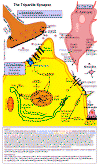|
Research News . . . .
Overview: Annual Meeting of the American College of Neuropsychopharmacology (ACNP) Meeting, December 8–12, 2002 The 41st annual meeting of the American College of Neuropsychopharmacology (ACNP) was held in San Juan, Puerto Rico, from December 8–12, 2002. Dr. Robert Post of Chevy Chase, MD, attended the meeting and gives a synopsis of the most important findings in bipolar disorder:
I. Overview There were several notable aspects of this meeting pertinent to bipolar illness: (1) in contrast to the last 9 or 10 prior ACNP meetings, there was an increase in the number of symposia dedicated to the topic of bipolar illness; and (2) there were striking new findings in both bipolar illness and schizophrenia. In recent previous meetings, there had consistently been an approximately 10-to-1 ratio of presentations on schizophrenia compared with bipolar illness, respectively. This year the ratio of presentations was more balanced toward equality, with a substantial number of symposia, presentations, and posters on bipolar illness and many new and exciting findings. This is particularly noteworthy as the prior programs at this meeting had suggested that less research was being done in bipolar illness than there should have been in relation to the representation of this illness in the general population (1-3%) and to the degree of distress and dysfunction that it is capable of causing. Thus, it is a positive sign for the field that new work is proceeding in bipolar illness. There was also an apparent paradigm shift in our understanding of the major psychiatric illnesses of bipolar disorder and schizophrenia. This is evident from three different bodies of evidence: A. Brain Microstructure There are now consistent replicable findings in the brain among a number of laboratories that unequivocally document that these illnesses affect the biochemistry and microstructure of the central nervous system (CNS). B. Genetic Vulnerability Factors There are now replicated genetic findings that appear to reflect a number of (perhaps minor) vulnerability factors for these illnesses, which is a distinct difference from the past when these genetic influences were sought but not found; at the same time there was an emphasis throughout the meeting that environmental events exert major effects on gene expression, and that these interact with genetic vulnerability in programming the neurobiology pertinent to the illness. C. Glial Cell Pathology There is clear evidence that glial cell pathology plays an important role in these illnesses; this evidence has now been almost unequivocally documented for schizophrenia and to a slightly lesser extent for bipolar illness as well.
II. Glia Neurobiology There are estimated to be approximately 10 billion nerve cells in the central nervous system and, in humans, the ratio of glia to neurons (10 to 1) is such that there are approximately 100 billion glial cells in the CNS. Thus, glial cells represent the most plentiful cellular elements in the CNS. Glial cells are the third member of the three-part component of every synaptic junction—pre-synaptic neurons, post-synaptic neurons, and glial cells—that is necessary for normal neuron-to-neuron communication and long-term learning and memory.
(Click on figure to enlarge)
|
Research News Archives 02/12/03 Oxcarbazepine Topiramate in Bipolar Disorder
|
